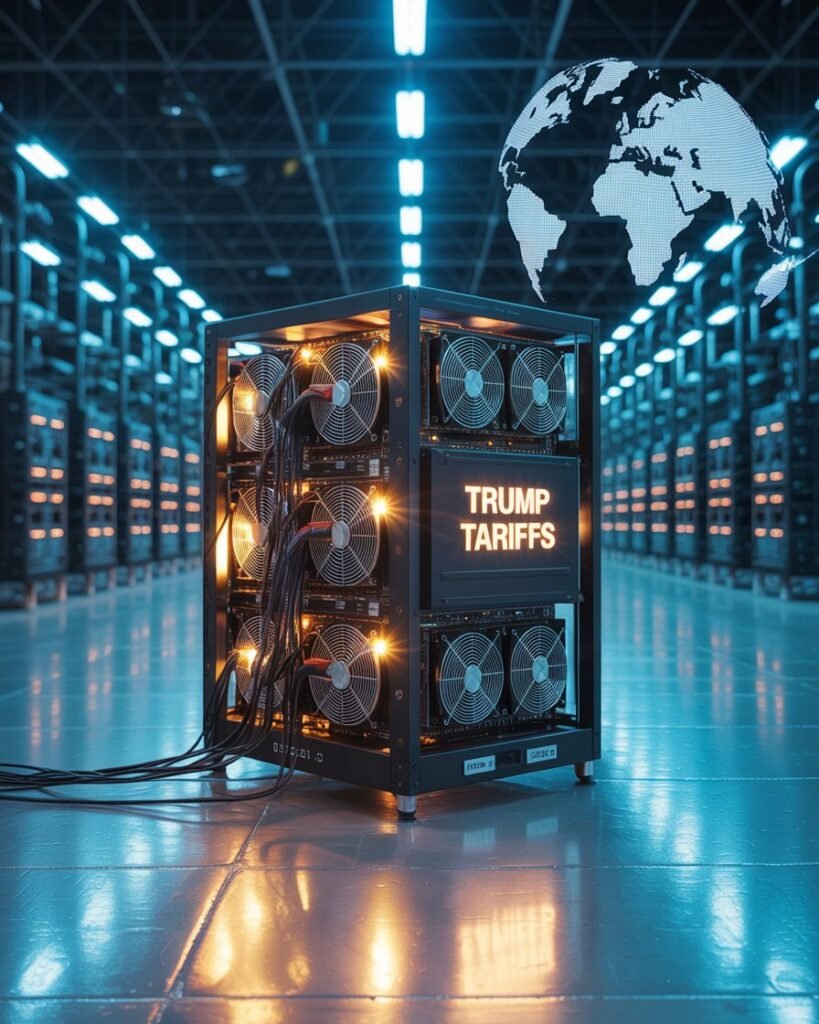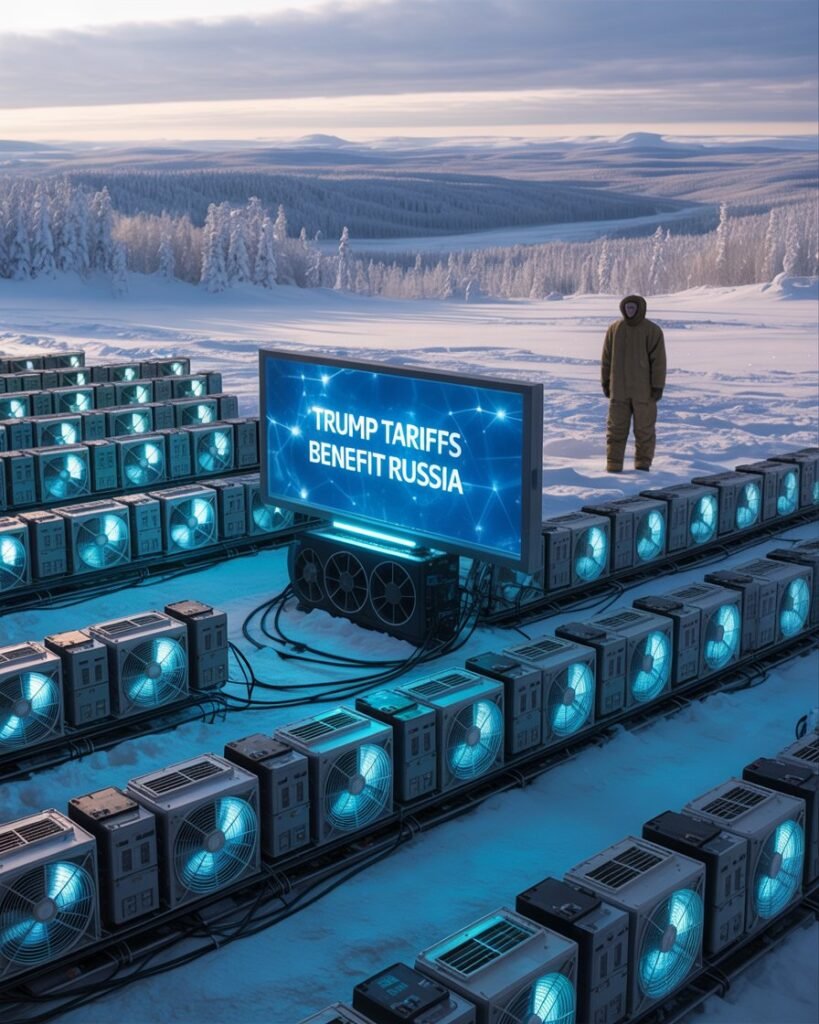In 2025, the Bitcoin mining tariffs 2025 introduced by the U.S. are reshaping the global Bitcoin mining landscape. President Donald Trump’s tariff hikes on imported mining hardware, primarily from China, threaten to increase costs for U.S. miners, who dominate ~40% of the global hashrate. As U.S. miners face premiums of 22-36% on equipment, Russia is poised to emerge as a major beneficiary, leveraging lower costs and strategic energy policies. This article explores the impact of Bitcoin mining tariffs 2025, Russia’s growing role, and the global shift toward emerging mining hubs. Stay ahead with Nexobytes’ real-time crypto insights!

Table of Contents
- U.S. Bitcoin Mining: The Tariff Challenge
- Why Russia Benefits from Bitcoin Mining Tariffs 2025
- Global Mining Shift: Emerging Markets
- Short-Term Strategies for U.S. Miners
- Long-Term Outlook: Manufacturing and Decentralization
- Technical and Economic Implications
- How to Prepare for the Mining Shift
- Conclusion
U.S. Bitcoin Mining: The Tariff Challenge
The U.S. has been a global leader in Bitcoin mining, contributing ~40% of the network’s hashrate, thanks to abundant energy and crypto-friendly policies. However, the Bitcoin mining tariffs 2025, part of Trump’s reciprocal tariff policy, are increasing costs for miners reliant on imported hardware from China, Malaysia, and Thailand. Current tariffs stand at 12.6%, with projections of 38.6% by July 2025, and Chinese goods facing up to 104% tariffs.
These tariffs target ASIC chips, critical for mining rigs like Bitmain’s Antminer S21. A Hashlabs report estimates a 22-36% cost increase for U.S. miners compared to global competitors, squeezing profitability as hashprice (revenue per unit of energy) hits all-time lows. Companies like Riot Platforms have sold Bitcoin to fund operations, diverging from their HODL strategy.
The tariff hikes, effective April 9, 2025, with a 90-day pause until July, have sparked market volatility. Bitcoin’s price dropped to ~$84,536, down 22% from its January high of $108,786, reflecting broader economic uncertainty.
Why Russia Benefits from Bitcoin Mining Tariffs 2025
Russia, the world’s second-largest Bitcoin mining hub, is set to capitalize on Bitcoin mining tariffs 2025. Ethan Vera, COO of Luxor Technology, predicts Russia will be the primary beneficiary due to lower equipment costs and strategic advantages. Russia’s mining capacity, valued at ~$3.5 billion in 2024, grew 7% last year, with 136,600 mining farms nationwide.
Russia’s advantages include:
- Cheap Energy: Regions like Irkutsk offer low-cost hydroelectric power, with miners consuming ~11 GW, though legal operations use only 3 GW.
- Legal Framework: Since August 2024, Russia legalized Bitcoin mining, taxing profits at 25% and exempting VAT, encouraging regulated growth.
- Sanctions Evasion: Bitcoin facilitates international trade, with Russia and China settling energy deals in BTC to bypass U.S. sanctions.
Chinese capital, previously invested in U.S. mining, may shift to Russia, boosting its hashrate. However, regional bans in energy-strapped areas like Dagestan, effective until 2031, could limit growth in some zones.
Global Mining Shift: Emerging Markets
The Bitcoin mining tariffs 2025 are accelerating a global redistribution of hashrate. Emerging markets with low energy costs and regulatory flexibility are gaining traction:
- Canada: Offers stable regulations and renewable energy, attracting miners diversifying from the U.S.
- Northern Europe: Countries like Iceland and Norway leverage cold climates and green energy for cost-effective mining.
- Latin America: Brazil, Chile, Argentina, and Paraguay benefit from cheap hydropower, with Paraguay emerging as a mining hub.
- Africa: Ethiopia’s low-cost electricity and untapped energy potential make it a future hotspot.
Bitdeer’s CEO, Matt LaBerge, notes that Bitcoin mining tariffs 2025 will drive growth in these regions, reshaping global hashpower distribution.

Short-Term Strategies for U.S. Miners
U.S. miners are adapting to Bitcoin mining tariffs 2025 with short-term measures:
- Pre-Tariff Procurement: Companies like Luxor are rushing deliveries before the July tariff hike, chartering cargo planes from Malaysia and Thailand.
- Stockpile Utilization: Existing U.S. equipment stockpiles are keeping costs down temporarily, but depletion looms.
- Operational Efficiency: Miners are optimizing energy use and upgrading to efficient rigs like the Antminer S21.
BitFuFu, a cloud mining provider, remains resilient, having secured thousands of S21 rigs pre-tariff. The company plans to expand U.S. operations, leveraging economies of scale.
Long-Term Outlook: Manufacturing and Decentralization
The Bitcoin mining tariffs 2025 highlight the U.S.’s reliance on Asian hardware, prompting calls for domestic manufacturing. Bitmain has explored U.S. production, but scaling would take years due to supply chain complexities. Sophgo chip restrictions further complicate efforts, as U.S. Customs has seized Bitmain rigs since 2024.
Globally, miners are decentralizing operations to regions with favorable conditions. Chinese capital may flow to Russia, Northern Europe, and Latin America, reducing U.S. dominance. This shift aligns with Bitcoin’s decentralized ethos, though it challenges Trump’s vision of a U.S. mining powerhouse.
Long-term, the industry may see innovation in energy-efficient rigs and alternative chips, reducing tariff impacts.
Technical and Economic Implications
The Bitcoin mining tariffs 2025 have technical and economic ripple effects:
- Hashrate Redistribution: As U.S. miners face higher costs, global hashrate may shift to Russia and emerging markets, potentially affecting network security dynamics.
- Energy Economics: Miners are prioritizing low-cost energy regions, with Russia’s hydroelectric and Africa’s untapped resources gaining focus.
- Market Volatility: Tariffs exacerbate Bitcoin’s price fluctuations, with altcoins like ETH dropping below $1,800, as seen in our Ethereum Pectra Upgrade Post.
Economically, tariffs act as a $400 billion tax on U.S. businesses, potentially triggering a recession, with J.P. Morgan forecasting 1.6% GDP growth in 2025. Bitcoin’s role as a hedge may grow if the U.S. dollar weakens, as seen in Russia-China energy trades.
How to Prepare for the Mining Shift
Investors and miners can navigate Bitcoin mining tariffs 2025 with these strategies:
- Hedge with Bitcoin: Hold BTC as a hedge against dollar devaluation, as suggested by VanEck’s Matthew Sigel.
- Diversify Operations: Explore mining in low-cost regions like Canada or Latin America.
- Invest in Efficiency: Upgrade to energy-efficient rigs to offset hardware costs.
- Monitor Policy: Track tariff developments post-July 2025 for strategic planning.
Conclusion
The rising tariffs on Bitcoin mining hardware in the U.S. are having significant ripple effects across the global mining landscape. While the U.S. has long been a leader in Bitcoin mining, these tariffs are pushing companies to explore alternatives in other regions. Russia stands out as the primary beneficiary, with lower costs and increasing investments positioning it as a key player in the future of Bitcoin mining.
At the same time, Canada, Latin America, and parts of Africa are becoming increasingly attractive for miners seeking low-energy costs and regulatory flexibility. As the global mining market adjusts to these new realities, the balance of power will likely shift, with emerging markets gaining prominence.
Bitcoin mining, once dominated by a few regions, is becoming a more globally distributed industry. The question now is: where will the next mining powerhouse emerge? As regions like Russia and others step into the spotlight, the future of Bitcoin mining is looking more dynamic and diverse than ever before.
Stay tuned for more updates as the global mining landscape continues to evolve in response to changing policies and economic factors.

